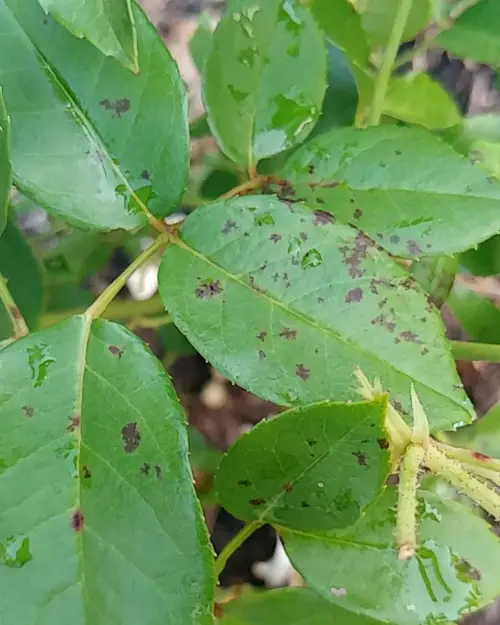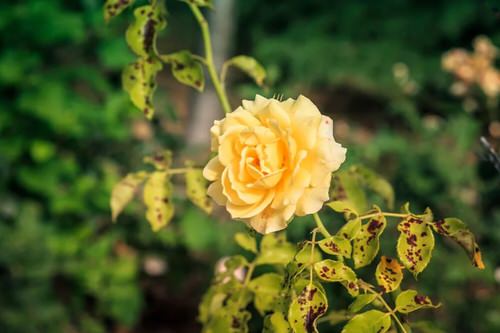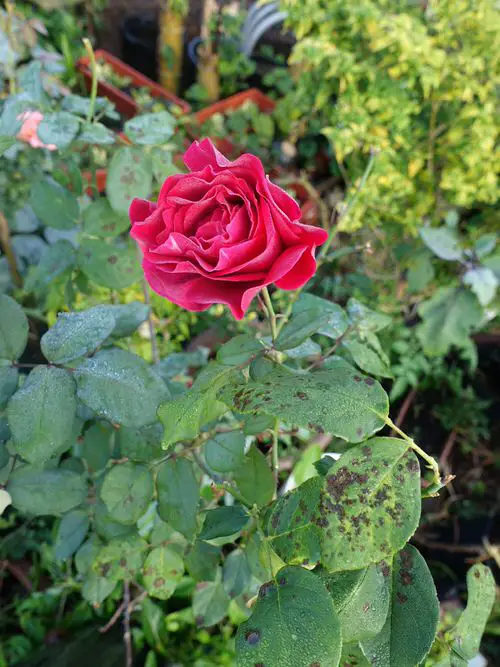Are you noticing Black Spots on Roses lately? If left unattended, this can be a serious problem. Don’t worry! Here’s how you can get rid of this disease.

Black Spots on Roses are one of the most common rose plant diseases and, if left untreated, can harm the entire plant, causing an untimely death. Fungus Diplocarpon rosae is the primary cause of the same, and in this article, we will discuss how to identify and prevent it.
What Are Black Spots on Roses?

Over time, Diplocarpon rosae, or black spot disease impacts roses, making them feeble, which results in fewer flowers. It also makes the plant susceptible to winter or heat injury. You can easily spot it by the black spots on the foliage. The exterior edges of these circles are scruffy or feathered and encircled by a pale yellow ring. They emerge on the upper and undersides of the foliage.
How Black Spot Disease Affects the Roses
This also affects young canes, resulting in black or dark brown blisters:
- The affected plant produces fewer flower buds, and leaves start falling.
- Soon it transfers to every part of the plant, which leads to stunted growth and unopened flowers.
- If not treated on time, the plant defoliates, withers, and dies.
Learn the right way to deadhead roses here
Roses that are Vulnerable to Black Spot
All rose varieties are somewhat vulnerable to black spot disease, but some are much more prone to it than others. According to the University of Nebraska-Lincoln Extension, hybrid tea roses, miniature roses, and grandifloras are most susceptible to this issue. So, if you’re growing many roses, it’d be better to look for resistant varieties to avoid this problem.
What Causes Black Spots on Roses?

The number one cause behind this fungal issue is prolonged moisture on the foliage and lack of air circulation.
1. Overwatering and Wet Foliage
This fungus loves to thrive in moisture, and overhead watering is the leading cause. Do not unnecessarily water the plants in a way that it wets the foliage, as this will make the roses highly susceptible to the disease. According to Texas AgriLife Extension–“To infect the rose plant, the spore on leaves must remain wet for at least 7 hours.”
This means if the weather is wet and humid or if you’re growing roses in a spot with low air circulation and low light, be mindful of watering.
2. Lack of Air Circulation
Proper airflow around the plants ensures that the leaves and stems are always dry, leaving no space for the fungus to thrive. Leave at least 1 to 2 feet of space between your rose canes for optimum air circulation.
3. Springtime
Diplocarpon rosae thrives best in the temperature range between 65 to 75 F (18 to 24 C), the most common temperature range during spring and probably summer. However, the high temperature above 85 F (30 C) restricts its growth. So, at the time when the temperature is in this range–you have to be extra careful, keeping the foliage dry and plants well ventilated.
4. Buying Infected Plants
The pathogen can also travel to your garden from a plant nursery. If you are buying rose shrubs, look closely for infected leaves on both the top and undersides of leaves.
Note: Young plants are most prone to this fungal issue as they don’t have the right defense system to safeguard themselves against it.
Check out some amazing tips to make roses bloom here
How to Prevent Black Spots on Roses?

1. Grow Disease Resistant Varieties
The simplest way to combat this problem is to grow disease-resistant varieties. Ask the expert in your local nursery or search online. Some of the varieties we can suggest are:
- William Baffin
- John Cabot
- Carefree Celebration
- Carefree Spirit
- Ballerina
- Duchesse de Montebello
- Madame Alfred Carrière
2. Make Sure they Get Plenty of Sunlight and Airflow
If you want to ensure, the plants stay out of the fungus’s way, provide them plenty of light. The more sun the roses are going to get, the better it would be for their health and flowers.
Also, you must space them out at least 1-2 feet from other plants so that they get good air circulation.
3. Water the Plants in a Right Manner
If possible, avoid overhead watering so as not to wet the foliage. Saturate the soil when the topsoil feels a bit dry to the touch. Also, it would be a great idea to form the habit of watering them in the morning as the plants will have ample time to dry up before the day ends.
4. Trim off Timely
Trim old and tangled stems and leaves as they can be hidden spots of moisture. It also ensures that you take away any diseased part, stopping it from spreading to the other parts of the plant.
Dump diseased leaves and canes and avoid putting them in compost or leaving them in the garden as the debris of it can spread infection again.
5. Protect from Wet Weather
If your rose bushes are already suffering from this disease, it would be best to provide protection from rain to prevent the wetting of foliage. If you’re growing them in pots, it’s best to shift them to a dry spot.
How to Treat Black Spots on Roses?

1. Insecticidal Soap
Use regular insecticidal soap after mixing it with water in a 1:3 ratio. It will take care of the fungus. If you want to make your own insecticidal soap–here’s the recipe!
2. Baking Soda
Take 1 quart of water, and add 1 teaspoon of baking soda and mild liquid soap. Fill the solution in a spray bottle and spray it on the affected area. Learn everything about this baking soda remedy in detail here.
3. Neem Oil
Neem oil penetrates inside the plant, so you are not required to re-apply it after rain. Though it can burn the foliage if used in a concentrated amount in hot weather. Discover more of this organic neem oil uses in garden here.
4. Milk
Mix milk with water in a 1:1 ratio and apply it using a soft cotton ball on the affected areas. You can also use it as a foliar spray. It promotes the growth of a certain fungus that feeds on the black spot. It works, and it’s proven by science!
5. Vinegar and Hydrogen Peroxide
Add a teaspoon of each to a liter of water, mix well, and pour this solution into a spray bottle. Use it as a foliar spray on the affected areas. We have more amazing vinegar and hydrogen peroxide uses in the garden listed here and here.
6. Use a Fungicide
If these things don’t work, use a powerful fungicide with copper or sulfur to control the disease quickly. Do refer to the label for dosage and instructions.
Conclusion
Apart from all these measures, it is important to note that this disease transfers from fallen leaves and stems–so discard everything carefully. And always sanitize your pruning shears after pruning a diseased plant.


